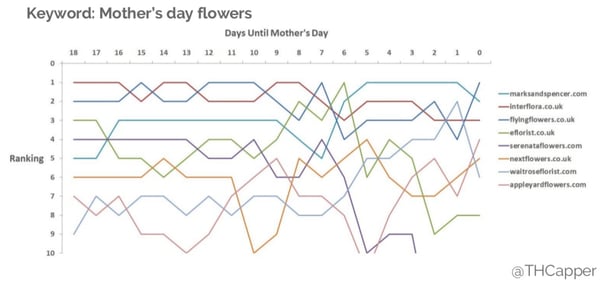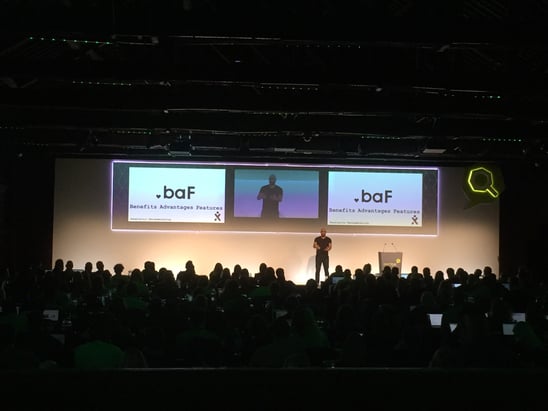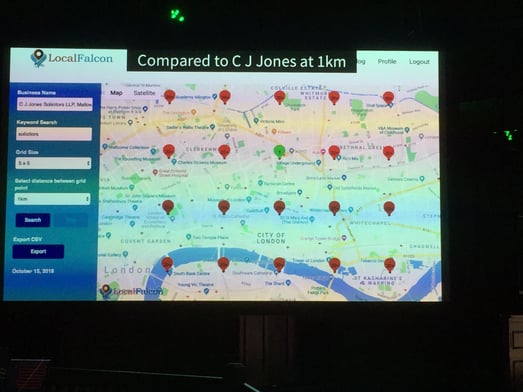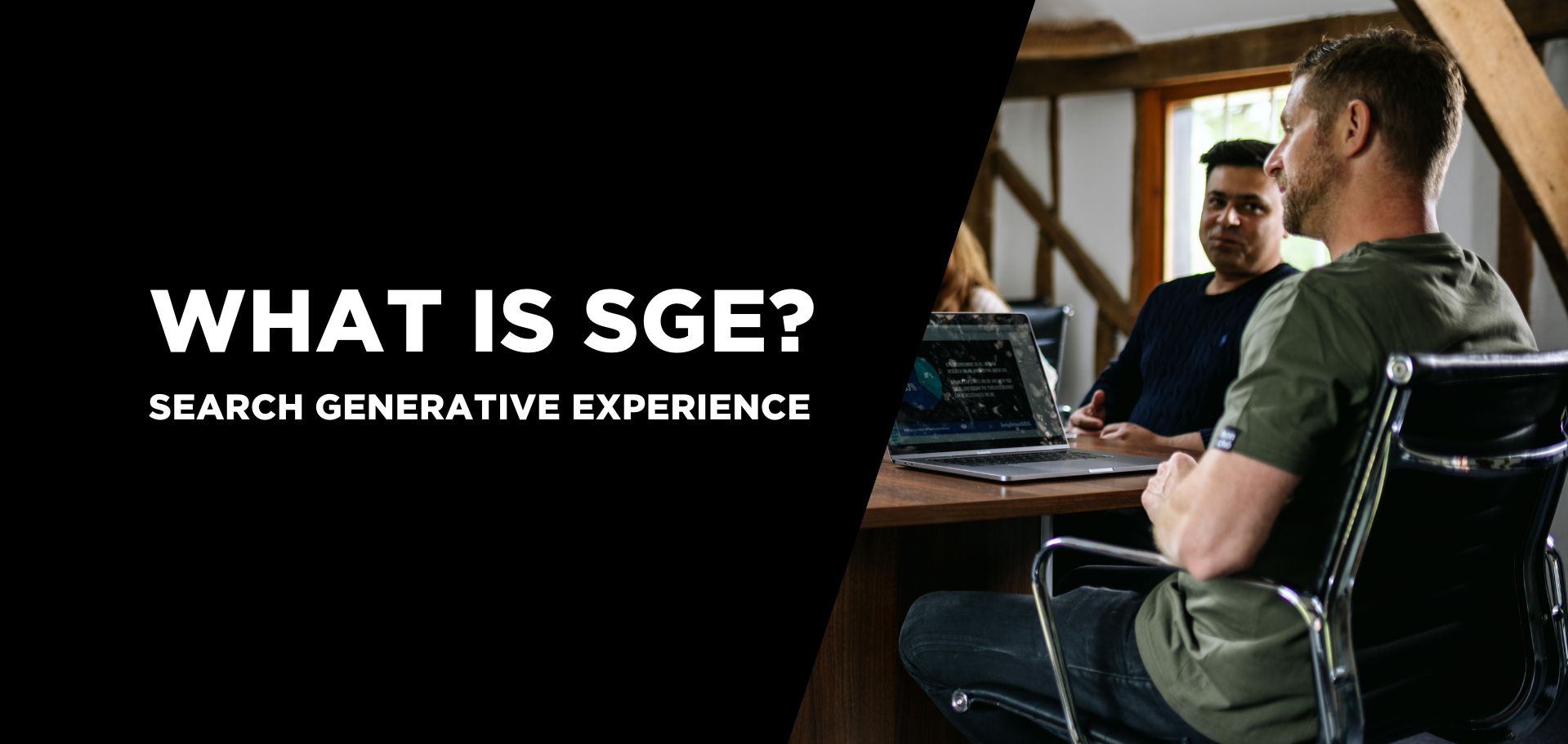iThinkMedia returned for another year at Search Love in London last week.
From Rob Bucci at GetSTAT, to John Mueller at Google, we weren’t short of insights from industry experts. So here’s some of our top takeaways from our trip to Search Love 2018.
Will Reynolds: 10 conversational changing values
Will Reynolds took us through visualisations that have helped the Seer Interactive team change conversations with clients, prioritise workloads and in general, get things done. Last year Will took to the Search Love stage with a presentation on how he uses PowerBI to bust silos by creating a data warehouse creating relationships between paid and organic data. He used PowerBI to evaluate the current keyword research state at all granularity levels that equated to £££.
This year, he took it a step further. He went into a lot of detail and demanded you check out his blog from last year first. We’ll let the slides take you through his talk but here are our 3 main takeaways.
Key Takeaways
- E-commerce websites can measure what end of the market they sell in by grouping products by price and comparing rankings against competitors.
- Use the PowerBI Bing maps integration and compare your visibility drilling down by competitor level postcode tracking to find pockets where brands can grow a postcode level.
- Build relationships to combine organic and paid data with location and keyword hierarchy breakdowns to create drill down visuals that of website at all granularity levels that equate to £££.
Rob Bucci. How distance and intent shape a local pack
As usual, Bucci delivered an insightful, data-driven talk about our ever-changing search landscape and how we can use ranking data to increase our understanding. Rob’s talk was all about local rankings and how Google is interpreting our explicit and implicit searches.
Key Takeaways
- No two geo-modifiers are the same. Google can understand ‘near me’ and far away intent.
- ‘Near me’ is more likely to reveal a map pack and have a higher weighting towards proximity.
- ‘In location’ will use the centroid of that location to base proximity. This means that hotels will endeavour to be right in the centre of cities.
- Organic results care more about the searchers geo-modifier than their location
- Local packs care more about the searcher’s location than their geo-modifier
- Every SERP is a localised search. If you’re not sampling rankings for local SERPs, then you aren’t seeing what your users are.
Bonus Tip
Branded keywords have a huge impact on your local search ranking results. Make sure you segment out to avoid skewed results.
Julie Scott. No one wants to watch another commercial
Julie Scott opened Search Love 2018 asking “when is the last time you scrolled through your social feed excited to click on ads?”
Through multiple examples of witty humour, the clear message she put across was that consumers want to be entertained, not watch adverts. Brands can leverage comedy and entertainment to maximise engagement with the target audience, just like The Onion.
Unfortunately, the talk felt more like a sales pitch, rather than actionable advice.
Key Takeaways
- Use comedy based on relatable human truths to fuel engagement.
- No one wants to watch an ad when they can watch something entertaining, so why not make your ad just that.
Tom Capper. The two-tiered SERP: Ranking for the most competitive terms
SEOs are often asked to explain rankings, and this job gets extremely hard when it comes to huge volume head terms. Tom explains how complicated SERPs have become and how page 1 can be two tiered with different ranking factors between position 1-5 and 6-10.
Key Takeaways
- The game has changed – Head terms are no longer about ranking factors:
- Links are less relevant in top 5 positions
- SERPs change drastically when they become high volume terms (on the approach to Mother’s Day, the SERPs become extremely volatile).
- Google is re-assessing intents for established keywords (with reference to the August ‘Medic’ update)

- Don’t abandon the foundations – As the industry gets more and more advanced it’s important not to forget about the basics. Do you research, create targeted pages and provide content that satisfies your user’s searches.
Ryan Charles – Newsjacking: How to add to the story and earn big links in real time
Ryan kicked off Day Two with a talk on “Newsjacking” as a way to get your brand noticed by hijacking topical news stories to get links and brand exposure.
One example included his use of the announcement that the San Diego Chargers were moving to Los Angeles. His moving company teamed up with other moving companies in the San Diego area and refused to move the team out of their home city, which attracted a huge amount of media attention and made the national news (and lots of juicy backlinks).
He also outlined the process for creating a successful Newsjack; running through how to spot a good opportunity, the importance of acting fast and the different ways you can connect a certain topical story to your business. He also gave some pointers on what not to do, using the example of a certain disastrous soft drink campaign, to prevent the strategy backfiring.
Key Takeaways
- Add value to the story – Whether it’s a comedic or emotional, make sure you’re adding something to the story. Your Newsjack isn’t likely to get picked up by any journalists or news websites if the content doesn’t have any real value.
- Don’t trivialise the story or situation – A successful Newsjack should not make the news story or topical content seem trivial, as it could turn into a PR disaster for your brand. Be careful with sensitive content – don’t try to turn it into a way to sell your product without thinking about the people involved.
- If it feels like a stretch, it probably is – Not every brand can successfully Newsjack every story. You need a solid connection for the strategy to work. Creating a strong campaign is crucial to a successful Newsjack, but if your connection to the story is weak it will undermine your content.
Bonus tip
Start local – It’s easier to get your story published locally, as local journalists will always be on the lookout for topical content to publish. If your campaign is strong enough, your story could pick up enough exposure to attract the attention of larger news organisations and websites.
Jamie Alberico. Creating Effective E-Commerce information Architecture
Jamie gave a very thorough explanation of the top things you should think about when creating and effective information architecture for E-commerce. At the same time this covered how to organise information to provide the best user experience possible. There were a number of great points in this talk, but here are some of the best.
Key Takeaways
- Break your sitemaps and GSC properties down into logical subgroups. This will help you to diagnose indexing issues.
- Strong and relevant internal linking – ‘If you want their money, respect their time.’ Create a structure that’s as flat as possible with logically related products and categories interlinked so customers have a smooth journey.
- Map your top auto-suggested ‘site search’ phrases to specific URLs. When people share links with their friends it should be a beneficial link.
Bonus tip
How to tell if your navigation needs improvement (and how to help sell it in):
Find the most powerful person in the company and ask them to find a product using only the faceted nav. Bet them money to do it in a time limit if it’s really poor!
Luke Carthy. How to nail SEO for discontinued products
In this talk, Luke Carthy explained why you should optimise your discontinued products and the benefits (and negative effects) it can have for your business. Demand often continues long after a product has discontinued. Just because you no longer sell a product doesn’t mean people are no longer searching for it.
Key Takeaways
- Engage visitors on entry – Show them a suitable alternative, and put your best benefits right in front of them e.g. free delivery, returns, voucher codes etc…
- Turn on discontinued products where there is still demand either from search or high quality backlinks. However, make sure you exclude them from internal search and your navigation. Set rules for how long discontinued products should remain online before redirecting to a like for like alternative.
- Check your backlinks to expired products – Argos had 135,851 backlinks from 2,800 referring domains pointing to discontinued products that now returned a 404.
Laura Hogan. Controlling branded SERPS and preventing negative press
Laura discussed the impact negative press can have on SERPs of your brand and how to remedy and control it. A company might have a huge social presence and lots of positive reviews, but negative articles in the SERPs can seriously damage your brand’s reputation.
Key Takeaways
- Showcase positivity on GMB: GMB is a lot more than your address and number now. There’s photos, posts, q&a, reviews and products. You are in full control of this and can utilise it to distract people from negativity, particularly on mobile as it takes up a lot of space.
- Clarity: If there are suspicions and allegations against your products and brand, take control. Invite bloggers to start posting about your truth to clear up any questionable things about your brand. So now when people search your brand they will see positive results and narratives appearing around your product in the SERPS.
- One negative review can turn off 25% of customers. Make sure it doesn’t destroy your reputation.
Andi Jarvis. People are predictable
Andi Jarvis shared an interesting study into the psychology of customer behaviour. He explained that when triggering the emotional part of your brain, it can lead to blind judgement and powerful marketing.
He talked about a study where people were given 3 glasses of wine and were told that they were all different wines. In reality, all 3 glasses were the exact same wine. In this study, a salesman elaborated described one glass of wine and gave it a story where it had been grown in a famous vineyard and made it sound exotic. Most users came back and said that was the best tasting wine, not knowing that they were all the same. This is the power of triggering the emotional part of the brain.

Key Takeaways
- Create ad campaigns that trigger the emotional part of the brain. Consumers are drawn in more by emotional hooks than product specifications. If we take a product description for a vacuum cleaner for example
- If you talk about features first… – If the first thing a user sees are features saying 500w and 600w vacuum cleaner they will naturally gravitate towards the 600w product as it’s higher.
- Talk about benefits and advantages first, then features – Benefits – healthier family and clean environment for everyone to see – by putting something like this first, it will emotionally resonate with people and the specs suddenly become a little less important. The personal description is what sets it apart from other products and where you can differentiate the models for people’s actual needs
- Invest in your brand’s awareness to make you stand out from a sea of competition. Consider above the line marketing if possible or cheaper adverts where your competition is appearing e.g. YouTube ads, Quora ads, display…
Bonus Tip
A study showed that people will often pick a product with a higher number of total reviews rather than a higher average rating.
John Mueller hosted by Distilled CEO Will Critchlow
Will Critchlow took to the stage with John Mueller to quiz him on the latest happenings in the search industry. As usual, John wasn’t able to give much away in terms of direct advice. However, he touch on two hot and unanswered topics. Here’s how Will Critchlow tweeted his summary:
- We all know that Google doesn’t use “Domain Authority” (the proprietary @Moz metric) but I felt that no-one had asked a googler a clear enough question on the record about similar domain-level metrics. We danced around it slightly, but I came away feeling that we had a clear answer from John that Google *does* have domain-level metrics that can affect whether a piece of content will rank better on domain A or domain B independently of the metrics of that specific page.
- Related to #1, I felt that we made real progress discussing the ongoing sub-folder / sub-domain debate. The summary of my understanding now is that Google *may* treat a sub-domain as a “part” of the main domain, and if it does, then all else being equal in internal and external linking etc, content will perform equally well in either place. *But* if the sub-domain is not treated that way, it can perform less well, hence case studies of uplifts from migrations. Unfortunately, there is no way to know in advance if your content is underperforming in this way / for this reason. (So: stick with sub-folders where you can IMO, and I’d still consider migrating)
Darren Shaw. Local Search has changed: here’s what’s working in 2018
Darren gave us a sneak peak behind 2018’s local search ranking factors report. He provided insight into the factors local businesses should focus on more, less and techniques that used to work well, but not anymore.

Key Takeaways
- Google Posts has been proven to have a direct impact on ranking factors, which could be driven by an increase in engagement signals. Businesses should focus on posting at least once a week (as posts expire every 7 days).
- Local citations are no longer as influential on rankings. They should be used to build the foundations, but not as a continuous long-term strategy.
- Ranking factors that local businesses should focus on most:
- Quantity of Google Posts
- Quantity of native Google reviews
- Add more videos and images to GMB locations
- Increase volume of topically relevant content to GMB landing page. Also refer to location specific entities e.g. close to the London Eye
- Increase quantity of links from industry and locally relevant domains
Bonus tip
Use Local Falcon (free resource) to see how you perform in local rankings as proximity increases around your business. A great tool for competitor analysis and proving the need to invest in local SEO.
Rebecca Brown. How to use SEO Data to increase the performance of PR campaigns
In Rebecca Brown’s talk, she emphasised the importance of SEO and PR teams working together to drive successful data-led campaigns.
When bridges are built between the two, SEOs can drive data directly into campaigns, enabling performance focused PR campaigns based on solid data.
Key Takeaways
- SERP analysis – Collaborate with those already dominating the SERPs, particularly if they are publications. Look out for older articles that need updating as quick wins.
- Content gap analysis – Work with PR to identify publications you wish to gain coverage in. Journalists will love it if you provide them with content that performs well and drives traffic to the publication they work for.
- Scrape Google news – this can tell you which publications are most likely to cover competitors and provide you with dates on when certain topics are being covered the most throughout the year.
Kirsty Hulse. Why people say no. How to spend less time fighting fear and more time getting shit done
Kirsty explained why PR campaigns aren’t resonating with their audience. Non-creative campaigns becoming less effective over time. Whereas, being creative is apparently 7x times more effective. Not being creative could even negatively affect your brand in the future.
According to Kirsty, as markets become more saturated we have to be bold and incite emotion. We need to have an emotional resonance with our consumers.
How can we be creative when nobody wants to take risks?
- ‘74% of CMOs said they are “unlikely” to take a creative risk with their brand’
- Believe in your ability to be creative – Kristy believes creativity is a skill that can be learned, developed and applied. If your day to day doesn’t require creativity, you’ll begin to think you aren’t creative. Don’t shy away from the opportunity to try.
- Practice and train your creative mind – “Creativity comes through play”. Businesses have to develop habits to enable their staff to become creative. It’s crazy for us to come with new ideas when we are sitting in the same space over and over. Go outside if possible. The colour green is proven to spark creativity as we associate it with growth and positivity.
- Anticipate objections – Take time to understand who you are trying to convince. When ideas aren’t getting signed off, it’s often down to fear from management. Data is only good for rational decision making. Plan for the worst case scenario and then say what you will do if that happens.
Bonus Tip
Play a confidence game before brainstorming to get your mind loosened up. This has been tried and tested to bring about more creative ideas.
Find great ideas in this book:
How to have creative ideas, Edward de Bond
Conclusion
As ever, Search Love 2018 provided a wealth of information from some of the search industries leading experts. We can say for certain that Google Posts should become a staple part of 2019 local marketing strategies. We learnt the importance of regularly practicing and encouraging creativity to ensure content, outreach and PR campaigns are resonating with our audiences.
Stay tuned for our follow up posts to this, where we will be diving into our learnings and applications from some of these great talks.





